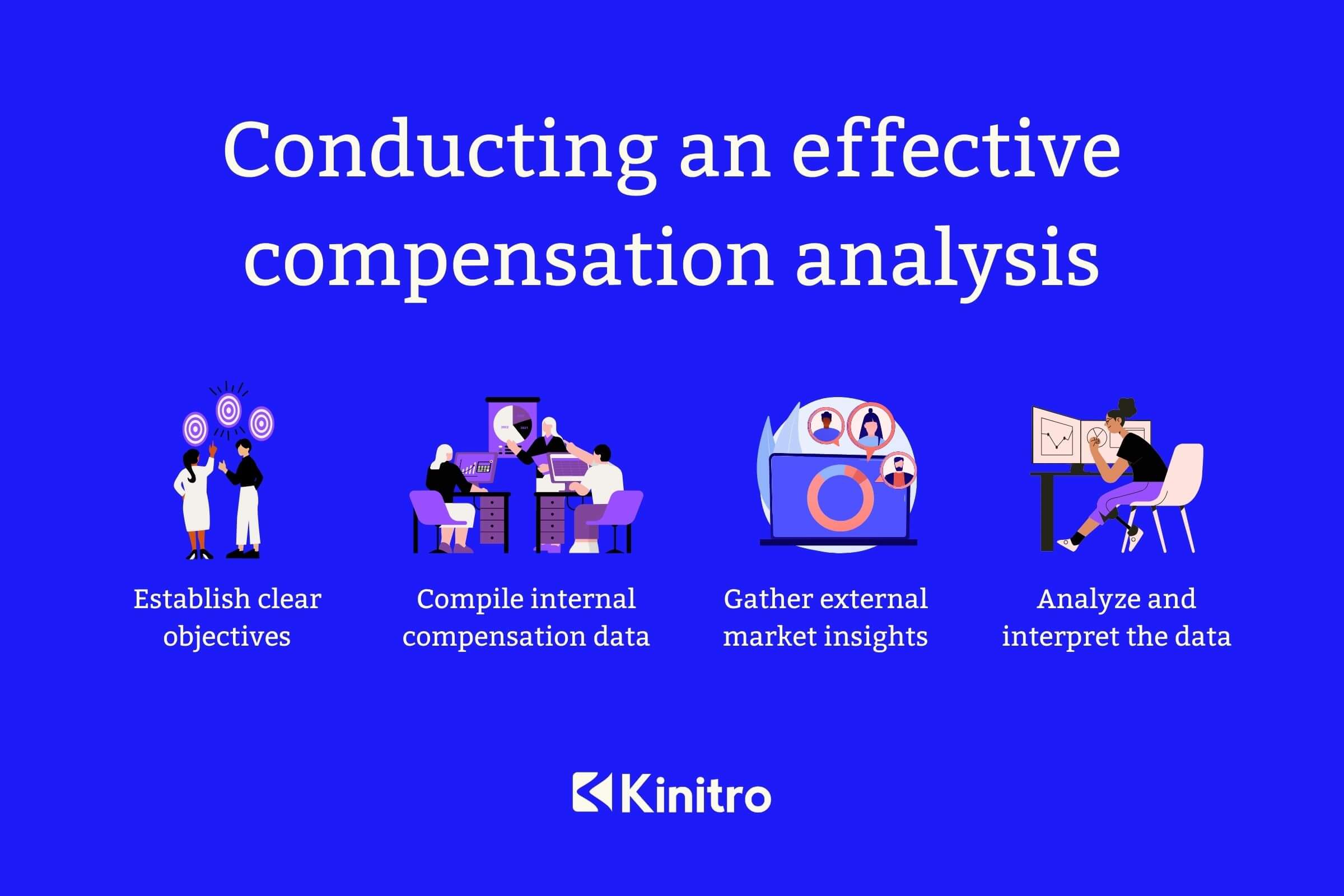Fair pay and employee satisfaction are vital components of a successful organization. Achieving these goals requires a thorough understanding of compensation analysis, which plays a crucial role in determining equitable pay structures, attracting top talent, and retaining engaged employees.
Key Takeaways
- Compensation analysis is an essential process for organizations to stay competitive in the job market.
- Organizations must assess and differentiate positions based on seniority, knowledge, and experience to ensure equitable pay structures.
- HR tech tools can be used to automate data collection, analysis, and reporting for streamlined compensation analyses ultimately leading to improved employee satisfaction.
Decoding Compensation Analysis: What It Entails and Why It Matters
Compensation analysis helps in the process of evaluating pay structures, benefits, and fairness within an organization using both internal and external data. At its core, the primary purpose of conducting a compensation analysis is to:
- Attract and retain top talent by offering competitive compensation packages
- Maintain fair employee compensation for job satisfaction
- Remain competitive in the industry
Given the competitive nature of today’s job market, conducting a compensation analysis is a necessity for organizations.
Companies must continuously analyze their compensation strategies to keep up with market trends and ensure that their employees receive competitive and equitable benefits. Regular compensation analyses allow organizations to identify potential disparities in pay, address any issues, and adapt their strategies to remain attractive to top talent.
A well-executed compensation analysis aids organizations in achieving a balance between employee satisfaction, talent attraction, and overall success.
Crafting a Robust Compensation Strategy
To develop a comprehensive approach to employee compensation, organizations must first formulate a compensation strategy that aligns with their overarching goals and objectives. This involves:
- Identifying potential issues or opportunities within the existing compensation structure
- Addressing these issues or opportunities accordingly
- Taking into account factors such as job descriptions, market rates, and employee roles
- Ensuring that compensation levels are both competitive and equitable
The Pillars of Employee Compensation
An employee’s compensation package typically comprises:
- Salary
- Bonuses
- Benefits
- Non-financial incentives
To establish a comprehensive salary structure that standardizes remuneration offerings and avoids discrepancies, organizations need to determine pay rates and wage ranges based on the training, expertise, knowledge, and experience required for each position.
To achieve both internal equity and external competitiveness, organizations must assess the fairness of compensation within their organization and compare it to the industry or region’s compensation standards.
Establishing job grades using market data or conducting job evaluations can help differentiate positions based on seniority or hierarchy within the organization. Utilizing internal data can further enhance these assessments.
Steps to Conducting Effective Compensation Analysis
A thorough compensation analysis involves several essential steps, from establishing clear objectives to gathering and leveraging compensation data and analyzing the findings.
In the following subsections, we will explore each of these steps in detail, providing a comprehensive guide to conducting an effective compensation analysis that drives organizational success.
Establishing Clear Objectives
Defining the goals and scope of the process is imperative to ensure a focused and effective compensation analysis. This involves considering factors such as specific job roles to be analyzed, the geographic region or industry in which the organization operates, and the specific goals of the analysis.
By formulating precise objectives, organizations can create a roadmap for the compensation analysis process that aligns with their overall business strategy.
In addition to aligning compensation analysis objectives with the organization’s goals, it is vital to consider variables such as experience, education, and past performance when determining actual compensation amounts within salary bands.
Gathering and Leveraging Compensation Data
Collecting relevant internal and external data is a critical component of the compensation analysis process. To conduct a comprehensive analysis, organizations must gather:
- Employee compensation data (salary, bonuses, benefits)
- Job descriptions and requirements
- Market surveys
- Industry benchmarks
Research reports, online databases, and current job listings can provide valuable insights into other businesses’ compensation packages, while focusing on companies of similar size and scope allows for a more accurate comparison.
In addition to collecting data, organizations must ensure that their analysis takes demographic factors such as age, gender, and ethnicity into account to prevent potential pay discrimination.
Regular compensation analyses are essential for staying informed about internal compensation trends and adjusting strategies accordingly. Effectively gathering and using compensation data allows organizations to make decisions that foster pay equity and enhance employee satisfaction.
Analyzing and Interpreting the Data
Once the data has been collected, it is essential to analyze and interpret the findings to identify trends, gaps, and opportunities for improvement in compensation practices.
Effective data analysis techniques include:
- Analyzing existing pay practices and philosophy within the organization
- Investigating market data to gain insight into industry benchmarks
- Assessing internal pay equity and competitiveness
- Ensuring current pay practices align with the company’s overall compensation strategy
The insights gained from the data analysis process can be used to inform future compensation and talent strategies, as well as to monitor employee surveys and key performance indicators (KPIs).
By using data analysis techniques to identify trends and areas for improvement, organizations can take a proactive approach to enhancing employee compensation, driving organizational success, and maintaining a competitive edge in the market.

Navigating Legal Compliance: Minimum Wage and Overtime Pay
Ensuring compliance with labor laws is a crucial aspect of designing and implementing an effective compensation strategy. Organizations must adhere to minimum wage laws, overtime regulations, pay equity, and equal pay laws to avoid potential legal issues and ensure fair compensation for all employees.
Currently, the federal minimum wage in the United States is set at $7.25 per hour, and employees must be compensated with overtime pay for any hours worked beyond 40 in a single workweek at a rate of at least 1.5 times their regular rate of pay.
Keeping updated with relevant labor laws and integrating them into compensation strategies, organizations can provide competitive and equitable compensation packages while adhering to applicable regulations. This not only fosters a positive work environment but also helps protect the organization from potential legal disputes and costly fines.
Prioritizing Pay Equity and Internal Equity
Addressing disparities in pay and promoting fairness within the organization are essential components of a comprehensive compensation analysis.
Pay equity ensures that employees are compensated fairly regardless of gender, race, or other factors, while internal equity focuses on achieving fair compensation within the organization, considering factors such as experience, training, and performance.
Prioritizing pay equity and internal equity in the compensation analysis process, organizations can establish a fair and competitive pay structure, promoting employee satisfaction and long-term success. HR tech tools can facilitate pay equity analysis by:
- Comparing compensation data across demographic factors
- Enabling organizations to identify and address pay gaps or disparities
- Ensuring fairness and compliance with equal pay laws
This helps organizations to establish a fair and equitable compensation system, fostering a positive work environment and attracting and retaining top talent.

Harnessing HR Tech for Streamlined Compensation Analyses
Utilizing technology can significantly enhance the compensation analysis process by automating data collection, analysis, and reporting. HR tech tools can help organizations with:
- Gathering and consolidating extensive data from multiple sources, including payroll systems, commission systems, and external salary surveys
- Further processing the data through analytics and machine learning algorithms
- Identifying trends, patterns, and discrepancies in compensation
This analysis helps organizations make informed decisions about their compensation strategies.
In addition to streamlining data collection and analysis, HR tech tools can also improve the overall efficiency of the compensation analysis process by reducing the need for manual data entry and minimizing the risk of human error.
Aligning Compensation with Performance: Incentives and Rewards
Designing incentive and reward programs that motivate employees and drive organizational success is a critical aspect of an effective compensation strategy. A performance-based compensation system includes:
- Linking employee compensation to individual and team performance
- Incorporating objectives, performance levels, and metrics to measure performance
- Pay elements such as salary and bonuses
Incentive and reward programs can:
- Increase productivity
- Foster loyalty
- Boost morale
- Enhance accountability among employees
By aligning compensation with performance, organizations can cultivate a mutually beneficial situation where employees feel motivated to contribute their best. This benefits the organization through improved productivity, higher work quality, and overall performance enhancement.
Tools like Kinitro can help streamline the implementation and management of complex incentive compensation programs, ensuring that organizations stay competitive in the job market and optimize their compensation strategies.
Adapting to Market Trends and Competitive Pressures
To stay competitive and respond to changing market conditions, organizations must continuously update their compensation strategies. Regular compensation analysis allows organizations to:
- Adapt their pay structures to accommodate market trends, such as inflation, labor market conditions, and competitive pressures
- Incorporate market trends into compensation strategies
- Make decisions and adjust their pay structures to remain competitive in the market.
It is recommended to conduct a compensation strategy review at least annually to stay competitive, with some companies opting for bi-annual reviews to ensure their strategies remain up-to-date with market trends.
Implementing Changes: From Analysis to Action
Turning compensation analysis insights into actionable steps for improving employee compensation and overall organizational performance is a critical aspect of the process.
Once the analysis is complete, organizations must take steps to inform future compensation and talent strategies, as well as to monitor employee surveys and KPIs.
Transparency is essential in the implementation of changes, fostering trust between employees and upholding a positive corporate culture during the process.
Following the implementation of a new compensation plan, organizations should:
- Conduct employee surveys to gather feedback on the effectiveness of the changes and identify any areas for improvement.
- Monitor key performance indicators (KPIs) to assess the impact of the changes on employee performance and overall organizational success.
- Take a proactive approach to implementing changes based on the findings from compensation analysis.
- Establish a fair and competitive pay structure that fosters employee satisfaction and contributes to long-term success.
By following these steps, organizations can ensure that their compensation plan is effective and supports the goals of the organization.
Summary
In conclusion, unlocking fair pay through compensation analysis is essential for organizations seeking to attract and retain top talent, ensure employee satisfaction, and drive overall success.
By understanding the intricacies of compensation analysis, crafting a robust compensation strategy, and harnessing HR tech for streamlined processes, organizations can create an environment where employees feel valued, motivated, and fairly compensated for their contributions.
The journey to fair pay begins with the understanding and application of compensation analysis – a powerful tool that can transform the way organizations approach employee compensation and set the stage for long-term success.
Frequently Asked Questions
How do you run a compensation analysis?
To run a successful compensation analysis, start by exploring the current state of compensation, determine which types of analyses to conduct, choose the right technology, run the calculations, address any challenges, communicate the results, and train managers.
What does a compensation analyst do?
A Compensation Analyst works with organizations to develop and maintain fair compensation structures. They research internal and external salaries, benefit packages, pay structure, and when raises are warranted, in order to attract and retain employees.
What is the primary purpose of conducting a compensation analysis?
The primary purpose of conducting a compensation analysis is to ensure that competitive compensation packages are offered to attract and retain top talent.







